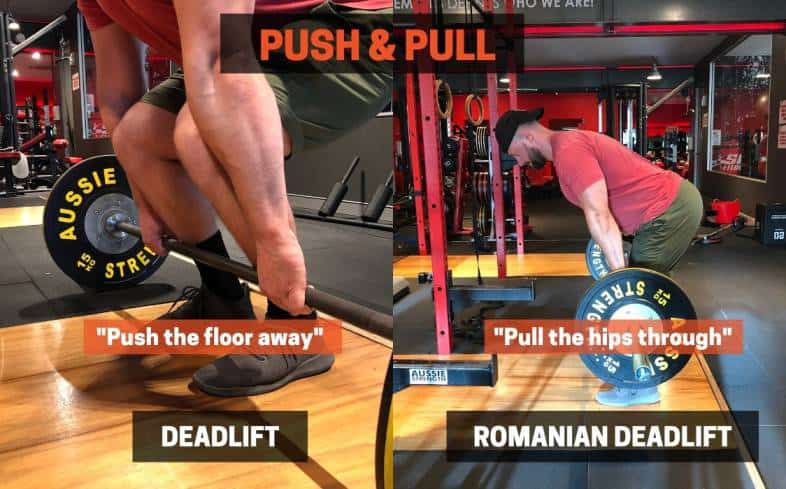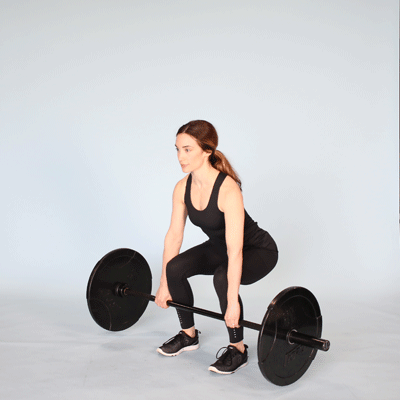The deadlift and Romanian deadlift have different forms and benefits. The deadlift involves a greater knee-bend and engages the quads more, while the Romanian deadlift targets the hamstrings and glutes.
Incorporating Romanian deadlifts into your workout routine can improve your conventional deadlift. Both deadlift variations are effective for body fat loss, but the sumo deadlift targets the quads, glutes, and inner thighs more. The Romanian deadlift is great for strengthening the low back, hamstrings, and glutes, resulting in improved squat or deadlift performance and reduced risk of injury.

Credit: www.boostcamp.app
Form And Technique
Discover the differences between the deadlift and Romanian deadlift, including their forms, benefits, and unique characteristics. Learn how the deadlift engages the quads while the Romanian deadlift targets the hamstrings and glutes, allowing you to choose the best exercise for your specific fitness goals.
Correct Deadlift Form
When it comes to performing a deadlift, it is crucial to use the correct form and technique to maximize its benefits and prevent injuries. The correct deadlift form involves:
- Maintaining a neutral spine: Throughout the movement, focus on keeping your back straight and avoiding any rounding or arching.
- Positioning your feet hip-width apart: Stand with your feet directly under the barbell, ensuring your weight is balanced.
- Gripping the bar: Use an overhand grip, ensuring your hands are shoulder-width apart.
- Engaging your core: Before lifting the bar, brace your core by taking a deep breath and tightening your abdominal muscles.
- Initiating the movement: Push through your heels while keeping your chest up and back straight as you lift the bar off the ground.
- Full extension at the top: Stand up tall and lockout your hips at the top of the movement.
By following these correct deadlift form guidelines, you can effectively target your hamstrings, glutes, back, and core muscles while minimizing the risk of injury.
Correct Romanian Deadlift Form
The Romanian deadlift is a variation that primarily targets the posterior chain, including the hamstrings and glutes. To perform the Romanian deadlift with proper form, follow these steps:
- Stand with your feet hip-width apart and hold the barbell in front of your thighs, using an overhand grip.
- Keep your chest up and shoulders back as you hinge at the hips, pushing them back while allowing a slight bend in your knees.
- Lower the bar down your shins, focusing on feeling the stretch in your hamstrings.
- Once you feel the stretch, engage your hamstrings and glutes to return to the starting position by squeezing your glutes and driving your hips forward.
- Ensure your back remains straight throughout the movement and gradually increase the weight as your form improves.
By executing the Romanian deadlift with correct form, you can effectively isolate and strengthen your hamstrings and glutes, improving your overall strength and athletic performance.
Benefits Of Deadlift And Romanian Deadlift
The deadlift is one of the most effective compound exercises for building overall strength and power. Here are some of the key benefits:
- Full-body workout: Deadlifts engage multiple muscle groups simultaneously, including the back, legs, glutes, core, and arms.
- Increased strength: Deadlifts are a great way to build overall strength, as they require you to lift heavy weight off the ground.
- Improved posture: Deadlifts help strengthen the back muscles, which can improve posture and reduce the risk of back pain.
- Better grip strength: Holding onto heavy weights during deadlifts can help improve grip strength, which is beneficial for other exercises and daily activities.
- Enhanced athletic performance: The deadlift is a functional movement that mimics activities in sports and everyday life, making it beneficial for athletes and individuals of all fitness levels.
The Romanian deadlift, also known as the RDL, targets specific muscle groups and offers its own set of unique benefits:
- Hamstring and glute development: The RDL places more emphasis on the hamstrings and glutes, making it an excellent exercise for building strength and muscle in these areas.
- Injury prevention: Strengthening the hamstrings and glutes through RDLs can help prevent injuries, particularly to the lower back and knees.
- Improved hip mobility: The RDL requires hip hinging, which can help improve hip mobility and flexibility.
- Greater control and stability: RDLs require control throughout the movement, helping to improve overall balance and stability.
- Functional movement: Like the traditional deadlift, the RDL mimics movements used in sports and everyday activities, making it a valuable exercise for athletes and individuals with specific functional goals.
Incorporating both deadlifts and Romanian deadlifts into your training routine can provide a well-rounded strength and conditioning program, targeting different muscle groups and offering a variety of benefits.
Differences Between Deadlift And Romanian Deadlift
When it comes to deadlift variations, the classic deadlift and the Romanian deadlift (RDL) are two popular options that offer unique benefits. While both exercises target the posterior chain and involve the use of a barbell, they differ in terms of form, muscle activation, and training specificity.
Biomechanical Differences
The biomechanics of the deadlift and the Romanian deadlift differ mainly in the movement pattern and range of motion. In the deadlift, the lifter starts with a hip hinge movement and grips the barbell using a pronated grip. As the lifter rises up, the movement involves the extension of the hip, knee, and ankle joints simultaneously. On the other hand, the Romanian deadlift begins with a hip hinge movement as well, but the focus is on keeping the knees slightly bent throughout the movement. The lifter lowers the barbell while maintaining a straight back and feeling a stretch in the hamstrings and glutes. The movement primarily involves hip hinge and hip extension, with minimal knee and ankle extension.
Muscle Activation
The muscle activation patterns differ between the deadlift and the Romanian deadlift. In the deadlift, a greater emphasis is placed on the quadriceps due to the deeper starting position and increased involvement of the knee joint. The glutes, hamstrings, and erector spinae muscles are also heavily activated. In contrast, the Romanian deadlift primarily targets the hamstrings and glutes, with less emphasis on the quadriceps. The erector spinae muscles are also engaged to maintain a neutral spine throughout the movement.
Training Specificity
The deadlift and the Romanian deadlift have different training-specific applications. Deadlifts are considered a more functional exercise as they closely mimic movements used in daily activities and sports. It involves a full-body exertion and is often used to improve overall strength, power, and athletic performance. On the other hand, Romanian deadlifts are commonly used to specifically target and strengthen the hamstrings, glutes, and lower back. They are often included in training programs to enhance hip hinge mechanics, improve hamstring flexibility, and prevent injuries associated with poor hamstring strength.
In conclusion, while the deadlift and the Romanian deadlift share similarities in terms of equipment and target muscles, they differ significantly in terms of form, muscle activation, and training specificity. Understanding these differences can help you choose the right variation based on your goals and training needs.

Credit: m.youtube.com

Credit: www.healthline.com
Frequently Asked Questions Of Deadlift Vs. Romanian Deadlift: Form, Benefits, And Differences
Why Romanian Deadlift Is Better Than Deadlift?
The Romanian deadlift is better than the deadlift because it focuses more on the hamstrings and glutes. The classic deadlift engages the quads to a greater degree due to its lower hip position and higher knee-bend. Romanian deadlifts target the hamstrings, glutes, and lower back, making them a great addition to your workout routine.
Is Romanian Deadlift A Good Substitute For Deadlift?
Yes, Romanian deadlift is a good substitute for deadlift because it targets the hamstrings, glutes, and lower back, which are important muscle groups used in the conventional deadlift. It can help improve your deadlift performance.
Which Deadlift Is More Beneficial?
The deadlift and Romanian deadlift are both beneficial exercises. The deadlift targets quads and hamstrings, while the Romanian deadlift focuses on hamstrings and glutes. Including both exercises in your routine can help improve overall strength and muscle development.
Do Rdls Make Your Deadlift Stronger?
Yes, RDLs can make your deadlift stronger by targeting the low back, hamstrings, and glutes, improving overall strength and reducing the risk of injury. They have a great carryover to other exercises like squats and can enhance running performance.
Conclusion
To summarize, the deadlift and Romanian deadlift are both effective for targeting multiple muscle groups, but differ in their form and focus. The deadlift engages the quads more due to a lower hip position, while the Romanian deadlift hammers the hamstrings and glutes.
Both exercises offer unique benefits and can be incorporated into a workout routine to enhance overall strength and muscle development. Ultimately, the choice between the two depends on individual goals and needs. Incorporating Romanian deadlifts can also improve conventional deadlift performance.
